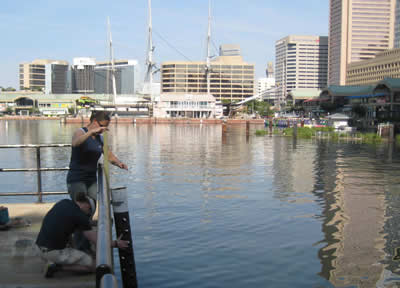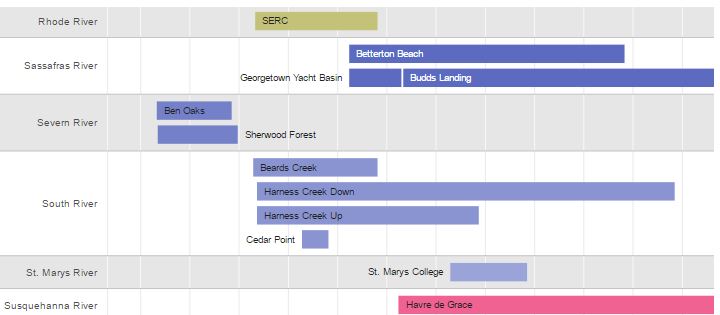Continuous Monitoring Program
The real-time/near-time Continuous Monitoring Program, which is funded in part by a grant from NOAA, is designed to collect water quality data throughout the Chesapeake and Coastal Bays in an effort to discern the links between water quality, harmful algal blooms, and fish kills.

The instruments generally used by the Continuous Monitoring Program are YSI 6600 and YSI EXO sondes. While some meters are anchored to the river bed (0.3m above bottom), most are located at a constant depth of 1m below the surface of the water. Each instrument is programmed to record seven parameters every 15 min: water temperature, salinity, dissolved oxygen (DO) saturation, DO concentration, pH, turbidity, and fluorescence (a measure of chlorophyll-α present in the water column). Some stations are also equipped with telemetry systems which provide real-time data. These 15min-increment measurements are referred to as 'continuous measurements' and can be accessed via Option 3 below.
Every two weeks, the water quality meters need to be exchanged for cleaning and calibration. During this time additional measurements are recorded by the scientists switching out the meters. In addition to recording water quality data (water temperature, specific conductance, salinity, dissolved oxygen, pH, etc) which are used for calibration comparisons and data quality assurance between the meters, they also measure secchi depth, photosynthetic active radiation (PAR)/light attenuation, and take samples for measurement of Total Suspended Solids (TSS), chlorophyll a and pheophytin a. Additionally, at some stations, samples are also taken for the measurement of VSS, PC, PIP, TDN, TDP, NH4,TN, TP, PO4, NO2, NO23. These data are referred to as the 'calibration data' and are available to download using either Option 2 or 3 below.
Continuous Monitoring Data Resources:
Click the titles or images below to navigate to each data resource.
1. Continuous Monitoring Station Timeline Chart : | |
| This interactive timeline graphic (Gantt chart) visually displays years of data available for all Continuous Monitoring stations. This tool can help when choosing sites of interest, and for comparing sampling longevity at, between, or among stations. |  |
2. Continuous Monitoring Station Information Table: |
|
| You can view and download basic Continuous Monitoring Station Information in table form, including station coordinates and information on depth locations of water quality meters at each station. This table also includes direct links to data downloads of 'Calibration Data' from the Chesapeake Bay Program's DataHub. | 
|
3. Continuous Monitoring Charts & Data Download: |
|
| Query for Continuous Monitoring 15-minute increment data, and choose to view your selection as a chart, download raw data, or view and download mean, minimum, and maximum values by year, month, or both. Copy the resulting URL to easily send collaborators your chart or data download. - Or - Want to compare conditions at two different stations? Use our Continuous Monitoring Station Comparison Chart and Data Download Tools instead. |

|
4. Continuous Monitoring Data Query Based on Parameter Ranges: |
|
| Query for Continuous Monitoring 15-minute increment data based on your desired water quality parameter ranges. Using parameter and value ranges you are interested in, this query will return stations and data matching all of the parameter ranges selected, within your selected date range. This is helpful for determining stations of interest based on water quality conditions. | |
5. Continuous Monitoring Mobile-Friendly Data Gauges: |
|
| View realtime data and near-realtime Continuous Monitoring data visually using our data gauges page. Displays data in a mobile-friendly and easy-to-read visual format from our telemetered/realtime data stations, as well as the most recent data recorded from non-telemetered stations. Great information for fishermen and open water swimmers - bookmark on your mobile device to view on the go! | |
